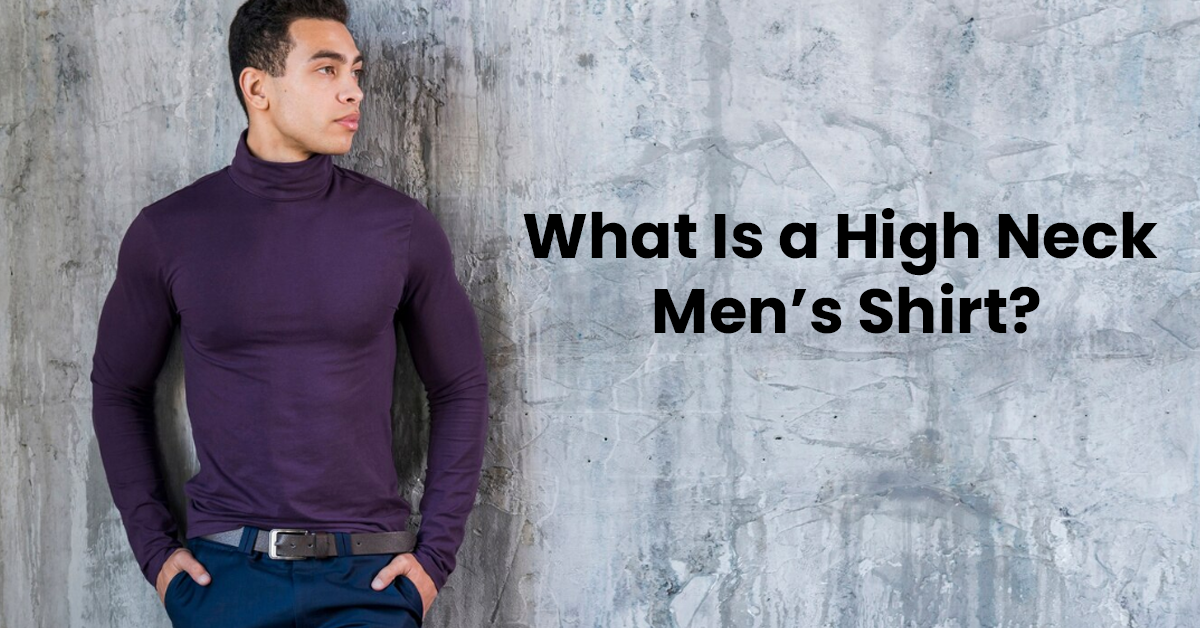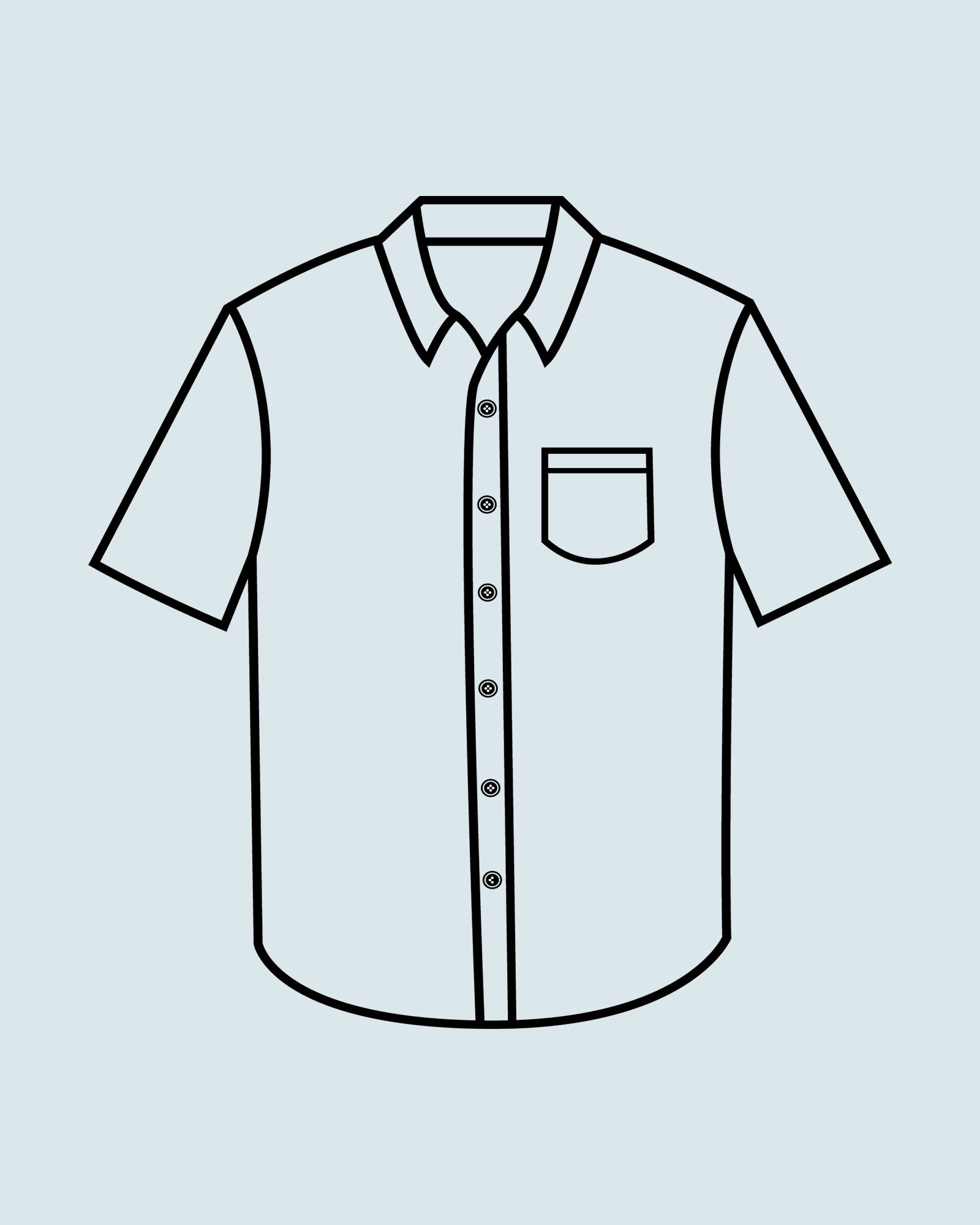What Is a High Neck Men’s Shirt? – Style, Function & Fit Guide
A high neck men’s shirt is more than just a cold-weather essential, it’s a statement piece that blends utility with modern edge. Defined by its elevated neckline that extends above the base of the neck, this shirt design has seen a major resurgence in recent years. Once considered a niche item, the high neck has made its way into everyday wardrobes through the influence of streetwear, luxury fashion houses, and minimalist style trends.
Today, high neck shirts are worn by fashion-forward men looking to combine warmth, structure, and aesthetic balance. From mock neck cotton tees in casual settings to fine-knit turtlenecks paired with blazers for semi-formal looks, this once-understated silhouette now holds a key place in versatile menswear.
In this guide, we’ll break down exactly what a high neck men’s shirt is, the different types available, how it compares to other necklines like crew and V-necks, and how to wear and care for them properly. Whether you’re shopping for a functional winter layer or exploring a new fashion-forward look, this article will help you make smarter style decisions based on fit, fabric, and seasonality.
What Defines a High Neck Men’s Shirt?
At its core, a high neck shirt is characterized by a raised neckline that extends above the collarbone, sometimes reaching partway up the neck or covering it entirely. Unlike traditional collars that fold over (like dress shirts), the high neck maintains a continuous fabric extension that either hugs the neck or sits loosely, depending on the design. This elevated construction not only adds warmth and structure but also contributes to a more defined upper silhouette, making it a popular choice in colder seasons or layered outfits.
High necks are commonly confused with other collar types but there are distinct differences. A crew neck sits flat at the base of the neck and offers minimal coverage, while a turtleneck fully covers the neck and often folds over itself. A mock neck, on the other hand, rises slightly but doesn’t fold, offering a sleeker, more minimalist option compared to a traditional turtleneck. The high neck term acts as an umbrella for these variations, encompassing everything from full turtlenecks and mock necks to more athletic or utilitarian designs like zip-up funnel necks and high-collar thermals.
These shirts appear across multiple categories from casual cotton tees and thermal base layers to tailored knits and athletic zip-ups. The design can be fitted or relaxed, lightweight or insulated, making it one of the most adaptable necklines in modern menswear. Regardless of how it’s styled, a high neck shirt delivers both function and visual refinement, which is why it’s become a wardrobe essential for men who prioritize form, comfort, and seasonal layering.
A Brief History of High Neck Shirts
The high neck shirt has a long and practical heritage rooted in functionality and protection. Originally designed for cold-weather wear and military uniforms, high neck garments provided essential insulation in harsh environments. Sailors, soldiers, and laborers often relied on these elevated necklines to shield themselves from wind and cold without the need for additional accessories like scarves. In the early 20th century, these garments were made using heavy wool or cotton, offering warmth and utility above all else.
As fashion evolved, the functional high neck slowly transitioned into mainstream menswear. The turtleneck, one of the earliest commercial adaptations, gained popularity in the mid-1900s for its sleek, intellectual appeal. It was no longer just about warmth, it became a statement. In the 1950s and '60s, creatives and academics wore turtlenecks as symbols of sophistication and counterculture. By the 1990s, mock necks and funnel necks appeared as style-forward alternatives to traditional collars, especially in European fashion circles.
Few garments have had as many iconic pop culture moments as the high neck shirt. Think of Steve Jobs, whose signature black mock neck became synonymous with minimalist innovation. In 1990s fashion, turtlenecks were often layered under suits or worn solo for an effortlessly cool look. More recently, high fashion brands have reintroduced high neck silhouettes on runways and in luxury streetwear, confirming their place in modern menswear across both function and form.
Different Types of High Neck Shirts
High neck shirts come in several variations, each offering unique benefits in terms of aesthetic, comfort, and use case. Understanding these styles helps you choose the right high neck shirt for your wardrobe and lifestyle.
Turtlenecks
The most classic variation, turtlenecks offer full neck coverage and often feature a fold-over design. They are ideal for cold climates, as the extra fabric around the neck traps heat. Turtlenecks can be found in lightweight knits for layering or in heavier materials like wool for standalone use. Whether paired with a coat or worn on its own, the turtleneck balances warmth with a timeless, intellectual edge.
Mock Necks
Mock necks provide the same elevated neckline as a turtleneck but with a shorter, non-folding collar. This makes them more breathable and easier to wear in transitional weather. They're also less bulky, making them ideal for layering under blazers, overshirts, or light jackets. Mock necks offer a cleaner, more modern silhouette while still maintaining a high-fashion appeal.
Zipper High Necks
Often seen in athletic or utility-style clothing, zipper high necks combine functionality with an urban aesthetic. These shirts typically feature a half-zip or quarter-zip closure, allowing for adjustable ventilation and styling. Perfect for workouts or outdoor wear, they’re commonly found in performance fabrics like polyester blends or fleece. Zipper high necks serve both as activewear and as part of athleisure-inspired casual outfits.
Funnel Necks
Funnel necks feature a wide, high collar that doesn’t fold down but rather sits loose around the neck. They offer a more relaxed and draped fit, making them a stylish layering option for fall and winter. This type of neckline works especially well in knitwear and sweatshirts, offering a balance of comfort, warmth, and visual texture.
How to Style a High Neck Shirt – Outfits for Every Season
The beauty of a high neck shirt lies in its ability to adapt across seasons while maintaining a refined, structured silhouette. From winter layering to casual spring statements, mastering how to style this piece can elevate your wardrobe throughout the year.
In winter, high neck shirts function as both an insulating base layer and a visual anchor. For a minimalist look, pair a black or charcoal mock neck with a tailored wool coat or bomber jacket. The raised neckline provides a clean contrast under outerwear, keeping your outfit sharp without needing scarves or bulky layers. Stick to neutral color palettes like navy, gray, or beige to keep the look refined and timeless.
During fall, mock necks come into play as mid-layer essentials. Wear a lightweight cotton or jersey mock neck under overshirts, denim jackets, or flannel button-ups. This adds both texture and dimension to transitional outfits while offering just enough warmth for crisp evenings. Earth tones like rust, olive, and sand pair beautifully with denim and corduroy for a seasonal, layered effect.
For elevated casual looks, lean into monochrome styling. A cream or slate-gray high neck paired with matching chinos or trousers delivers a sleek, modern silhouette perfect for brunches, casual dates, or gallery visits. Finish the look with a leather jacket for an edge or a minimalist coat for a more artistic tone.
Accessories play a critical role in finishing your high neck outfit. The higher neckline naturally frames the face and upper chest, creating a perfect backdrop for slim chain necklaces or pendants. Pair with minimalist watches, clean sneakers, or Chelsea boots, and in colder seasons, add beanies or scarves tucked under the collar for both warmth and visual layering.
High Neck vs. Crew Neck – Which Should You Wear?
Choosing between a high neck and a crew neck shirt comes down to both function and facial structure, and each neckline serves a different role in your wardrobe.
A high neck provides more coverage and warmth, making it a go-to in colder months or when building structured, layered outfits. Its upward silhouette draws the eye vertically, which works especially well on men with longer necks or angular jawlines. High necks also visually slim the frame, making them a strong choice for fitted looks and minimalist fashion. They're ideal for smart casual, elevated streetwear, or cold-weather layering under coats and jackets.
On the other hand, a crew neck sits flat at the base of the neck and offers a more open, breathable look. This makes it suitable for year-round wear, especially in casual or athletic settings. Crew necks tend to broaden the upper chest visually, making them a great option for those with narrower shoulders or shorter necks. They pair easily with jeans, shorts, or joggers, and serve as a clean base for basic layering.
In terms of face shape, high necks generally favor oval or rectangular faces, enhancing structure. Crew necks work better with round or broader faces, offering balance without accentuating width. If you're dressing for comfort, everyday wear, or gym sessions, crew necks often win. But for a more curated, fashion-forward approach especially in colder weather high necks offer superior form and versatility.
Sizing & Fit Tips for High Neck Shirts
A well-fitted high neck shirt should offer both comfort and structure, balancing form with function. When worn correctly, it frames the upper body without restricting movement making it ideal for layering or wearing solo. But getting the right fit depends on more than just your standard shirt size.
The neck fit should be snug but not tight. You want the fabric to sit smoothly around your neck without creating pressure or bunching. A proper high neck will follow the natural curve of your neck and jawline whether it's a turtleneck fold or a mock neck rise. If you feel like the shirt is choking you or sagging below the collarbone, it's likely the wrong size or cut.
Next, look at the shoulders and chest. The shoulder seams should align perfectly with your natural shoulder bone. If the seam drops too far, the shirt will look oversized and lose its structured effect. Similarly, the chest should contour the upper torso without pulling or gaping. For a more tailored look, choose a fit that slightly hugs the body; for relaxed styling, a looser cut works especially with funnel or zip necks.
Sleeve length and shirt length also matter. For long-sleeve high necks, the sleeves should stop right at your wrist bone too long, and they bunch; too short, and the shirt looks undersized. The bottom hem should land just below the waist, not too cropped and not long enough to bunch up when tucked.
Material is the final factor in fit. Cotton jersey and wool knits stretch slightly, making them more forgiving in sizing. Structured performance fabrics offer less give but hold their shape longer. When in doubt, opt for blends that offer both elasticity and structure, ensuring the neck doesn’t warp over time.
Caring for High Neck Shirts – Wash, Fold & Store Without Stretching
High neck shirts require thoughtful care to maintain their shape, texture, and longevity especially around the collar, which is most prone to stretching and curling. Preserving the integrity of the neckline not only extends the shirt’s lifespan but also ensures it continues to look sharp and structured through every wear.
When it comes to washing, always check the label first. Most high neck shirts especially cotton, wool, or blends benefit from cold or lukewarm water on a gentle cycle. To minimize neckline distortion, turn the shirt inside out and avoid overloading the machine. Skip fabric softeners on performance materials, as they can break down elasticity over time.
For drying, air drying is your best bet. Lay the shirt flat on a towel or drying rack to help it retain its shape especially around the collar and shoulders. Avoid hanging the shirt by the neck, as this can lead to stretching. Never use high heat in the dryer; the neck seam and fabric integrity can be compromised permanently.
Folding and storage also play a major role. Always fold high necks flat rather than hanging them especially turtlenecks and mock necks made from soft fabrics. If you must hang, use wide, structured hangers that support the shoulders and avoid putting tension on the collar area.
Fabric type will dictate specific care. Wool high necks should be hand-washed or dry cleaned to avoid shrinkage. Cotton and blends can handle machine washing but still benefit from delicate handling. Performance high necks, like zip collars or training gear, often dry fast and resist wrinkles but can lose shape if not washed with care.
Conclusion: High Neck Shirts Are a Timeless Upgrade to Modern Menswear
Whether you’re layering up for winter, aiming for a minimalist statement, or just experimenting with smarter silhouettes high neck shirts are more than just a seasonal trend. They combine function, warmth, and style in one refined design that works across occasions and body types.
By understanding the different types of high necks, how they fit, what materials to choose, and how to style them for every season, you’ll be able to make smarter wardrobe decisions that go beyond basics. And with the right care, your high neck shirt will keep its structure, comfort, and visual appeal for years to come.



